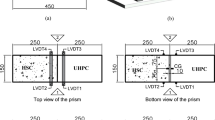Abstract
This paper presents analytical part of an investigation on the application of prestressed strips for concrete confinement. In this paper, an analytical model is proposed to predict the compressive stress–strain curve of strapped concrete as a function of the confinement level. The model was calibrated based on the experimental data of compressive tests which were described in part A of this paper. Various parameters are considered in the proposed model including volumetric ratio, yield strength and ultimate strain of confining material, shape of cross section, strength of plain concrete. Three key points were defined on the stress–stress curve of strapped concrete columns and applied in model definition including critical, yield and ultimate points. The model showed good capability in predicting the compressive stress–strain curve of tested strapped concrete specimens. The model is also compared to some of the conventional confinement models in prediction of the strength gained by post-tensioned strips. In addition, a plasticity model was applied in the nonlinear finite element analysis of prismatic and cylindrical tested specimens with various levels of confinement. It is shown that these models are able to predict the experimental results, reasonably.














Similar content being viewed by others

References
Richart FE, Brandtzaeg A, Brown RL (1928) A study of the failure of concrete under combined compressive stresses. University of Illinois, Urbana Champaign, vol 26, no 12
Balmer GG (1949) Shearing strength of concrete under high triaxial stress-computation of Mohr’s envelope as a curve. Research laboratory report no SP-23, Denver
Moghaddam H, Samadi M, Pilakoutas K (2008) Behavior and modeling of high-strength concrete columns confined by external post-tensioned strips. In: Proceedings of ASCE/SEI structural engineering congress, Vancouver, Canada
Mander BJ, Priestley MJN, Park R (1988) Theoretical stress-strain model for confined concrete. J Struct Eng 114(8):1804–1826
Madas P, Elnashai S (1992) A new passive confinement model for the analysis of concrete structures subjected to cyclic and transient dynamic loading. Earthq Eng Struct Dyn 21(5):409–431
Frangou M, Pilakoutas K (1995) Structural repair/strengthening of RC columns. Constr Build Mater 9(5):259–266
Lubliner J, Oliver J, Oller S, Oñate E (1989) A plastic-damage model for concrete. J Solids Struct 25:299–329
Sheikh SA, Uzumeri SM (1982) Analytical model for concrete confinement in tied columns. J Struct Eng 108(12):2073–2722
Eurocode 8: Design provisions for earthquake resistance of structures, BSI 1998
Saatcioglu M, Razvi SR (1992) Strength and ductility of confined concrete. J Struct Eng 118(6):1590–1607
Ahmad SH, Shah SP (1982) Complete triaxial stress–strain curves for concrete. J Struct Eng 108(4):728–742
Cusson D, Paultre P (1995) Stress-strain model for confined high strength concrete. J Struct Eng 121(3):468–477
Razvi S, Saatcioglu M (1999) Confinement model for high-strength concrete. J Struct Eng 125(3):281–289
Lokuge W, Sanjayan JG, Setunge S (2005) Stress–strain model for laterally confined concrete. J Mater Civ Eng 17(6):607–616
Sargin M, Ghosh SK, Handa VK (1971) Effects of lateral reinforcement upon the strength and deformation properties of concrete. Mag Concrete Res 23(75–76):99–110
Kent DC, Park R (1971) Flexural members with confined concrete. J Struct Div ASCE 97(7):1969–1990
Popovics S (1973) A numerical approach to the complete stress-strain curve of concrete. Cem Concr Res 3(5):583–599
Chen WF, Saleeb AF (1994) Constitutive equations for engineering materials, vol 2 (Plasticity). Elsevier, London
Moghaddam H, Samadi M (2009) On the effect of ductility of confining material on the concrete ductility. In: Proceedings of ASCE/SEI structural engineering congress, Austin, TX, USA
Priestley MJN, Seible F, Calvi GM (1996) Seismic design an retrofit of bridges. John Willey and Sons, New York
Newman K, Newman JB (1971) Failure theories and design criteria for plain concrete. In: Proceedings of the international civil engineering materials conference on structures, solid mechanics, and engineering design. Wiley Interscience, New York, pp 936–995
Park R, Priestley MJN et al (1982) Ductility of square-confined concrete columns. J Struct Eng 108(4):929–950
Fafitis A, Shah S (1985) Predictions of ultimate behavior of confined columns subjected to large deformations. ACI Struct J 82(4):423–433
Karabinis AI, Kiousis PD (1994) Effect of confinement on concrete columns: plasticity approach. J Struct Eng 120(9):2747–2767
Hoshikuma J, Kawashima K, Nagaya K, Taylor AW (1997) Stress-strain model for confined reinforced concrete in bridge piers. J Struct Eng 123(5):624–633
Bousalem B, Chikh N (2007) Development of a confined model for rectangular ordinary reinforced concrete columns. Mater Struct 40:605–613
Attard MM, Setunge S (1996) Stress-strain relationship of confined and unconfined concrete. ACI Mater J 93(5):432–442
CEB-model code 90 (1993) Design of concrete structures, CEB-FIP Model Code 1990, MC CEB-FIP - 1993 - Thomas Telford
Author information
Authors and Affiliations
Corresponding author
Appendix A: The more accurate alternative for Eq. 11
Appendix A: The more accurate alternative for Eq. 11
As described in Sect. 3.4, an accurate equation for the pre-yield branch of the stress–strain curve must satisfy five constraints. Therefore, a forth order polynomial is required to simultaneously satisfy all of the constraints:
The coefficients of this polynomial are so obtained that it pass through origin, critical and yield points and also its slopes at the origin and yield point become equal with E c and α, respectively. These coefficients were obtained as follows:
Rights and permissions
About this article
Cite this article
Moghaddam, H., Samadi, M. & Pilakoutas, K. Compressive behavior of concrete actively confined by metal strips, part B: analysis. Mater Struct 43, 1383–1396 (2010). https://doi.org/10.1617/s11527-010-9589-5
Received:
Accepted:
Published:
Issue Date:
DOI: https://doi.org/10.1617/s11527-010-9589-5



